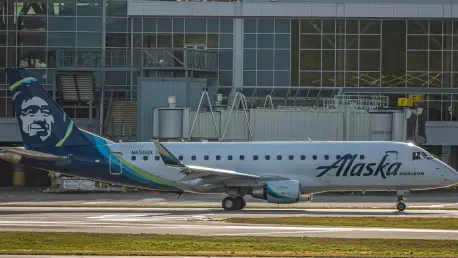On October 23, a catastrophic IT outage struck Alaska Airlines, grounding flights across its entire system and stranding nearly 50,000 passengers in a chaotic two-day disruption that exposed the fragility of technological infrastructure in an industry where every minute of downtime leads to cascading delays. This incident, far from isolated, highlighted the critical need for IT resilience—a key factor determining whether airlines can weather technical storms or crumble under their weight. As aviation increasingly relies on digital systems for everything from ticketing to flight operations, the spotlight has turned to building robust IT frameworks. This analysis delves into the growing trend of prioritizing such frameworks in aviation, using Alaska Airlines’ recent challenges as a lens to explore industry-wide vulnerabilities, responses, and the path forward for operational stability.
IT Outages at Alaska Airlines: A Case Study in Vulnerability
Scope and Impact of Recent Disruptions
The October 23 outage at Alaska Airlines triggered a system-wide halt of both Alaska and Horizon-operated flights, marking one of the most severe disruptions in the airline’s recent history. Affecting nearly 50,000 passengers, the ground stop lasted two days, with normal operations only resuming by October 25. This extended downtime underscored the profound impact a single technical failure can have on an airline’s network, revealing systemic weaknesses that demand urgent attention.
A similar incident earlier in July further illustrates a troubling pattern of recurring IT failures for Alaska Airlines. These repeated disruptions suggest that underlying issues in the airline’s technological backbone have yet to be fully addressed. The frequency of such events raises questions about the adequacy of current systems to handle the demands of modern aviation operations.
The scale of these outages, particularly the October event, highlights how quickly a technical glitch can spiral into a major operational crisis. Beyond immediate flight cancellations, the ripple effects disrupted connecting flights and strained resources across the airline’s network. Such incidents serve as stark reminders of the high stakes involved in maintaining reliable IT infrastructure in this sector.
Real-World Consequences and Passenger Experience
Passengers bore the brunt of the October outage, facing widespread flight delays and cancellations that upended travel plans on a massive scale. Many were left stranded at airports, grappling with limited rebooking options and inadequate communication about when services would resume. The sheer volume of affected travelers amplified the chaos, turning routine journeys into logistical nightmares.
Alaska Airlines publicly acknowledged the inadequacy of its response, labeling its performance during the outage as “not acceptable.” This admission reflects the depth of frustration among passengers and the airline’s recognition of its failure to meet expectations. The incident starkly contrasted with the company’s stated mission to deliver a “world-class guest experience,” exposing a significant gap between aspiration and reality.
The broader consequence of these disruptions is the erosion of customer trust, a vital asset in a competitive industry. Repeated IT failures risk alienating loyal travelers, who may turn to competitors perceived as more reliable. For Alaska Airlines, rebuilding confidence will require not just technical fixes but also a renewed commitment to transparency and passenger support during crises.
Investments and Responses: Alaska Airlines’ Push for Stability
Technological Investments and Infrastructure Upgrades
In recent years, Alaska Airlines has significantly ramped up its focus on technology, boosting IT investments by nearly 80 percent over a notable period. Key initiatives include the development of redundant data centers and the migration of guest-facing systems to cloud platforms like Microsoft Azure. These efforts aim to create a more robust framework capable of withstanding unexpected failures.
However, the October outage, which originated from a primary data center failure, casts doubt on the effectiveness of these redundancy measures. Despite substantial financial commitments, the incident suggests that backup systems may not be as fail-safe as intended. This discrepancy between investment and outcome points to potential flaws in planning or execution that need deeper scrutiny.
Skepticism also surrounds the airline’s definition of “redundant data centers,” with questions arising about whether these systems are truly independent or merely extensions of a vulnerable core. The gap between claimed preparedness and actual performance during critical moments indicates that financial input alone cannot guarantee stability. A more strategic approach to infrastructure design appears essential for lasting resilience.
Strategic Partnerships and Corrective Measures
To address its persistent IT challenges, Alaska Airlines has enlisted Accenture, a leading consulting firm, to conduct a comprehensive audit of its technological infrastructure. The goal is to identify root causes of recent failures and implement quick fixes to prevent future disruptions. This partnership signals a proactive, if somewhat reactive, step toward stabilizing operations.
Earlier disruptions this year prompted the airline to claim it had taken measures to strengthen its systems, yet the October outage reveals that these efforts fell short. The recurrence of issues despite prior interventions suggests that deeper systemic problems persist beyond surface-level solutions. This pattern underscores the complexity of achieving true IT reliability in a high-stakes environment.
Additionally, the airline faces a dual challenge of internal vulnerabilities and external dependencies, such as reliance on cloud services like Microsoft Azure. While a recent Azure outage was mitigated by backup systems, allowing continued booking and check-in functions, it highlighted the risks of third-party platforms. Balancing internal upgrades with robust contingency plans for external failures remains a critical focus for the airline’s strategy.
Industry Perspectives: IT Resilience as an Aviation Priority
The struggles of Alaska Airlines are not unique but rather reflective of a broader trend within aviation, where IT resilience has emerged as a top priority. Industry reports consistently emphasize that technical disruptions and cybersecurity threats pose significant risks to airlines worldwide. From booking systems to air traffic control interfaces, the sector’s dependence on digital tools leaves little margin for error.
Examples of other airlines grappling with similar issues—ranging from data breaches to system outages—reinforce the notion that Alaska Airlines’ challenges are part of a systemic vulnerability. These incidents collectively highlight how interconnected and technology-driven aviation has become, amplifying the consequences of even minor glitches. The industry as a whole faces pressure to fortify its digital defenses.
Expert consensus stresses that while investments in technology are indispensable, their strategic deployment and reliability under stress are equally crucial. Throwing money at the problem without rigorous testing or clear protocols often yields limited results, as seen in various cases across the sector. Thoughtful implementation, rather than sheer expenditure, appears to be the linchpin of preventing operational crises in aviation.
Future Outlook: Building a Resilient IT Framework in Aviation
Looking ahead, the aviation industry stands to benefit from advancements in IT resilience, such as enhanced redundancy mechanisms and more robust cloud solutions. Innovations in predictive analytics could enable airlines to anticipate and address potential failures before they escalate. Additionally, stronger cybersecurity measures are vital to protect against growing threats in an increasingly digital landscape.
For airlines like Alaska, improved system stability promises significant advantages, including restored customer confidence and streamlined operations. A reliable IT backbone can minimize disruptions, ensuring smoother travel experiences and reducing the financial losses tied to outages. These benefits, however, hinge on a willingness to prioritize long-term solutions over short-term fixes.
Challenges persist, notably the high costs associated with overhauling legacy systems that many airlines still rely on. Coupled with the risks of third-party dependencies, such as cloud service outages, the path to resilience is fraught with obstacles. Addressing these hurdles requires not only financial commitment but also a cultural shift toward proactive risk management within the industry.
The broader implications for aviation weigh positive outcomes against lingering risks. Seamless travel experiences and operational efficiency are achievable with the right frameworks, yet persistent vulnerabilities could undermine progress if left unresolved. The industry must navigate this delicate balance, ensuring that technological advancements translate into tangible reliability for passengers and stakeholders alike.
Conclusion: Lessons and Next Steps for Aviation IT
Reflecting on the events surrounding Alaska Airlines’ IT outages, it becomes evident that recurring disruptions pose a severe threat to operational integrity and customer trust. The substantial investments made in technology, while commendable, proved insufficient without effective implementation, as demonstrated by repeated failures. Strategic partnerships, such as the collaboration with Accenture, offer a glimmer of hope but also underscore the depth of systemic issues that demand urgent resolution.
Moving forward, airlines need to embrace a mindset of relentless innovation, prioritizing long-term system stability over temporary patches. Industry-wide collaboration emerges as a powerful tool, with stakeholders encouraged to share insights and develop standardized protocols for IT resilience. By investing in cutting-edge redundancy, robust cybersecurity, and comprehensive staff training, the aviation sector can fortify itself against future disruptions, ensuring that passengers experience reliability rather than frustration.









